This is part three of a series of posts about the development of women’s six day races from 1981 onwards. The series documents the women who set the world record for six days. In 1981, Marcy Schwam of the USA became the first woman to compete in a six day race since the revival of the format in 1980. Her “new era” record of 384 miles stood for just over a year. For the next two years, Nottingham was the place where the record was rewritten. Firstly, in 1982, when 23-year-old British runner, Ros Paul, broke Schwam’s record with a distance of 407 miles 741 yards. Secondly, in 1983, when Eleanor Adams ran 409 miles 1178 yards.
The Charles Rowell Six Day Race, Nottingham
The race was named after Charles Rowell, a successful professional pedestrian of the Victorian era from Cambridge. Rowell competed in the 1870s and 1880s and raced against the American Edward Payson Weston. The race where Marcy Schwam set the record in 1981 was named after Payson Weston.
The Charles Rowell Six Day Race took place five times, from 1981 to 1985. The race venue was the Harvey Hadden stadium in Nottingham with its 400m tartan athletics track.
At the inaugural race in November 1981, seventeen men competed, including Don Choi from the USA, organiser of the first modern six day race in 1980, held in the USA. Mike Newton of South London Harriers won, covering just over 505 miles, a “new era” record.
From 1982, the race date moved to the summer, taking place in July or August. In 1982, there were 25 runners, including Don Choi and Mike Newton again. Ros Paul was the only woman in the race.
The Third Charles Rowell Six Day Race was held from 31st July to 6th August 1983. Nottingham Building Society sponsored the race and provided several volunteers. Runners had to have qualified by running 100 miles or more in 24 hours.1
Eleanor Adams ultrarunner

By 1983, Adams had only been road running for four years. She had run her first marathon, the inaugural People’s Marathon, in May 1980. Adams raced nearly every weekend, mainly in cross country (in the winter) and road races over a range of distances. Between January and July 1983, she had competed in three marathons in the UK, winning all of them with times under three hours.
In her first ultra, a 12 hour track race in Nottingham, in July 1982, she only expected to run about 30 miles but wanted to see how far she could cover. She was astounded to be told by the organisers that she had set several world bests.2 In her very first race, Adams had made her mark in the world of ultrarunning.
By the time of the Charles Rowell race, Adams had competed in four further ultras, all of them track races:
16th October 1982 – Road Runners Club 100k Race, Copthall
20th to 21st November 1982 – 24 Hour Race, Bingham
16th to 17th April 1983 – Vienna 24 Hour Race
9th to 10th July 1983 – Spenco 24 Hour Race, Solihull
Adams had set world bests for ultra distances up to 50 miles at Copthall and Bingham. Taking on a six day race was a big step up in distance and endurance.
Eleanor Adams and the Charles Rowell Six Day Race
Adams’ introduction to ultra distance racing came when she went to watch the first Charles Rowell Six Day Race with her husband John in November 1981. This sparked her interest. They both got asked to do some lap counting and then Eleanor ended up running with some of the competitors. She went back every day whilst her children were at school. In 1982, following her performance in the 12 hour track race in Nottingham, she was invited to take part in the Charles Rowell race despite not having the qualifying standard of 100 miles in 24 hours. Reluctantly she declined as she had not done enough training. Eleanor and John watched the second race and saw Ros Paul set the world record.
When interviewed by Maurice Dillon, shortly before the Vienna 24 Hour race, Adams commented:
You must realise this time last year I hadn’t even heard of a twelve hour race, let alone 24 hours and I thought six days were something cyclists did.
Adams had just received confirmation of her acceptance for the Charles Rowell race and was looking forward to the challenge. She was planning to build up her overall mileage which had been averaging 100 miles/week since January.
As I have to train on my own most of the time I have decided to enter a number of marathons at fairly frequent intervals and use these as basis for strength and stamina training.
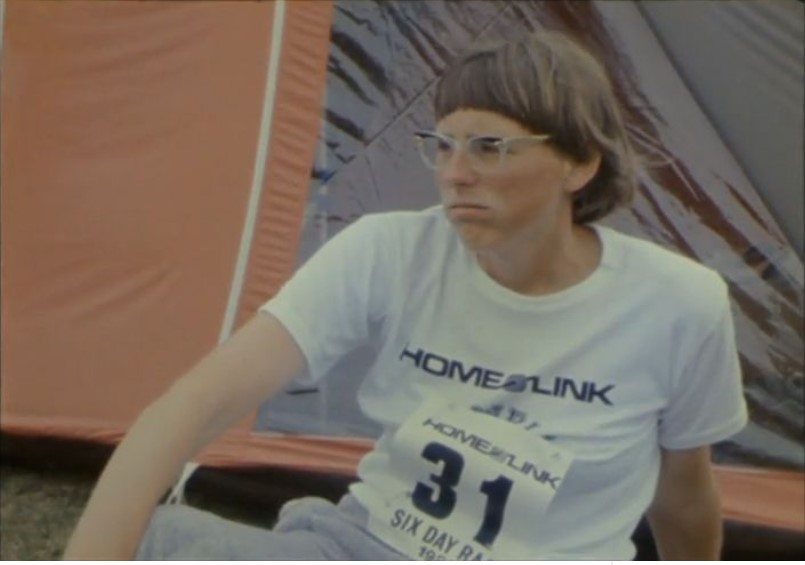
A still image of Eleanor Adams from the BBC news report from the race
The race
The 27 competitors, 23 men and four women, included athletes from Australia, Austria, France and the USA.
Two of the pre-race favourites in the men’s race, Brian Harney and Colin Dixon of Great Britain, retired after less than 100 miles. The other favourite, Joe Record of Australia, only completed 158 miles.
At the end of the first day, British ultrarunner Lynn Fitzgerald (b.1947) was in the overall lead with 127 miles. She had set two world bests. Firstly, for 100 miles (15:44:21) beating the mark set by Marcy Schwam by just six seconds. Secondly, for 200km (21:38:40) beating her own previous world best. Fitzgerald withdrew after this, leaving Gerard Stenger of France and British long-distance walker John Dowling to compete for first place overall.
After four days, Eleanor Adams was running well, in fifth place behind Dan Coffey and her Sutton-in-Ashfield AC teammate Alan Fairbrother. She had a big lead of 23 miles over the three men in sixth to eighth places. She had run 293 miles and set several intermediate world bests. Adams was struggling with an injury and Malcolm Campbell commented that she was reduced to walking in the last eight hours of the race. This allowed the three men, Campbell, Marvin Skagerberg (USA) and Edgar Pattermann (Austria) to overtake her. She finished 8th.
In an article about her ultrarunning career in the Road Runners Club newsletter in January 1985, Adams described her frustration at picking up an injury.
I built up carefully for the Nottingham Six-Day event, and found that everything went to plan up to the third day when I was troubled with shin splints and lack of medical treatment. I was reduced to a hobble for the rest of the event, but I just managed to surpass Roz Paul’s world best mark with 408 miles. I finished feeling very frustrated, and wondering what might have been, if I had been able to run the final three days.
The BBC Look North televsion news programme sent a reporter to the race. His report includes an interview with Adams where she describes the shin splints and says she is applying ice every two hours. Her husband came up with the idea of putting frozen cucumber slices inside her socks and the film shows this.
Maurice Dillon described her performance in the following terms:
…her courage and resolution under circumstances of sheer physical exertion were put to the test during the last day when she suffered debilitating pain in both shins causing her at times to move at the unbelievable pace of only two miles an hour. For Eleanor the last day was something of a nightmare and for the final 24 hours she virtually had to stay on the track all the time in order to get the world record. This do-or-die performance must be one of the bravest accomplishments by a woman athlete this, or any other century.
According to contemporary reports, such as the Road Runners Club newsletter, Eleanor Adams’ result was 409 miles 1178 yards (659.298km). The Deutsche Ultramarathon Vereinigung UV has a slightly shorter distance – 408 miles 1626 yards (658.099km).
1983 Charles Rowell Six Day Race results
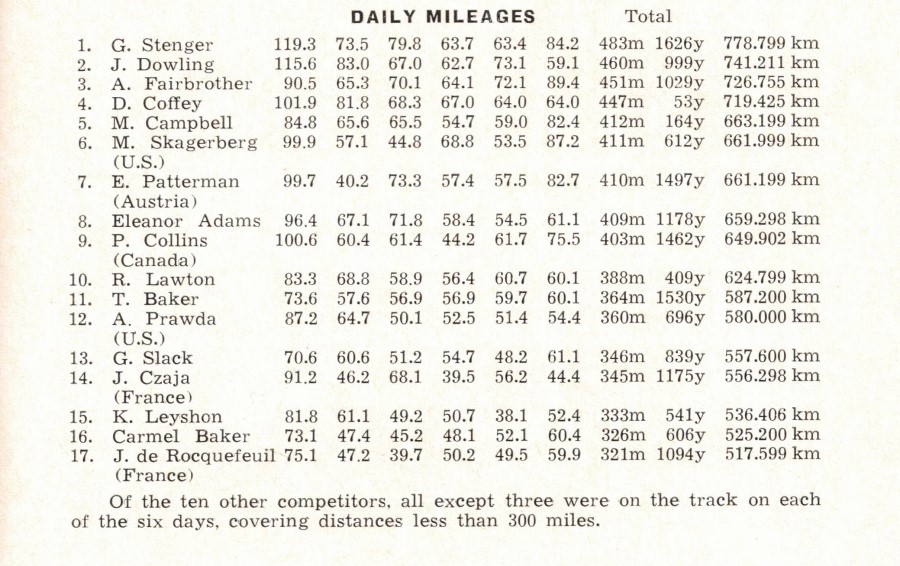
Race results from the Road Runners Club newsletter, January 1984.
The four women in the race were Lynn Fitzgerald, Eleanor Adams, Carmel Baker (b.1940) and American Beverly Nolan (b.1934). The newsletter only listed those runners who had exceeded 300 miles. Nolan completed just under 260 miles (418.000km). Fitzgerald, who withdrew after 24 hours, ran just under 128 miles (205.600km).
Carmel Baker was another local runner. She had competed in the Lincolnshire 100km road race on 19th June that year. Along with her husband, Tom, she was a member of the now defunct Carlton Forum Joggers in Nottingham. Tom was also in the race, finishing in 11th place. Carmel’s distance of 326 miles 606 yards was a masters record (v40+) for six days. In 1984, she returned to the Charles Rowell Six Day Race, finishing first with 412 miles 1582.5 yards (664.497km), ahead of Eleanor Adams. Baker finished in 10th place overall. She had exceeded the world best Adams had set in 1983 but the mark had moved further on by then. 412 miles was no longer good enough to be a world best. (Tom Baker finished 19th and 22nd overall.)
In conclusion
The Charles Rowell race marked the start of an outstanding career as a multi-day racer which saw Eleanor Adams set the six day world best six times. 1984 was to be the stellar year in the modern history of the women’s six day race. The world best changed hands five times that year.
Notes
Summary of the world record progression
1. The qualifying standard is mentioned in “New Record for Longest Run?”, Lincolnshire Echo, 27th July 1983.
2. A race report by Geoff Richardson in Ultrarunning magazine September 1982 states that Adams set world track bests for 20 miles, 25 miles, 40 miles and 50 miles at the Nottingham 12 hour race. Her performances were acknowledged but could not be ratified as there weren’t enough Road Runners Club timekeepers in attendance.
Sources
Interview with Eleanor Robinson, 6th June 2018.
“Interview: Eleanor Adams – My life is very complicated”, Marathon and Distance Runner, June 1983
“Nottingham six day race”, Maurice Dillon, Marathon and Distance Runner, October 1983
“The Third Charles Rowell Six Day Race”, Malcolm Campbell, Road Runners Club Newsletter, January 1984
Article by Eleanor Adams, Road Runners Club newsletter, January 1985
BBC Look North news report, 6 Day Marathon, 4th August 1983
Photos
Banner photograph: Harvey Hadden Stadium in 1983 by Edgar Lloyd, purchased from Picture Nottingham
Image of Eleanor Adams running from Marathon and Distance Runner, June 1983, credited to Nottingham Free Press
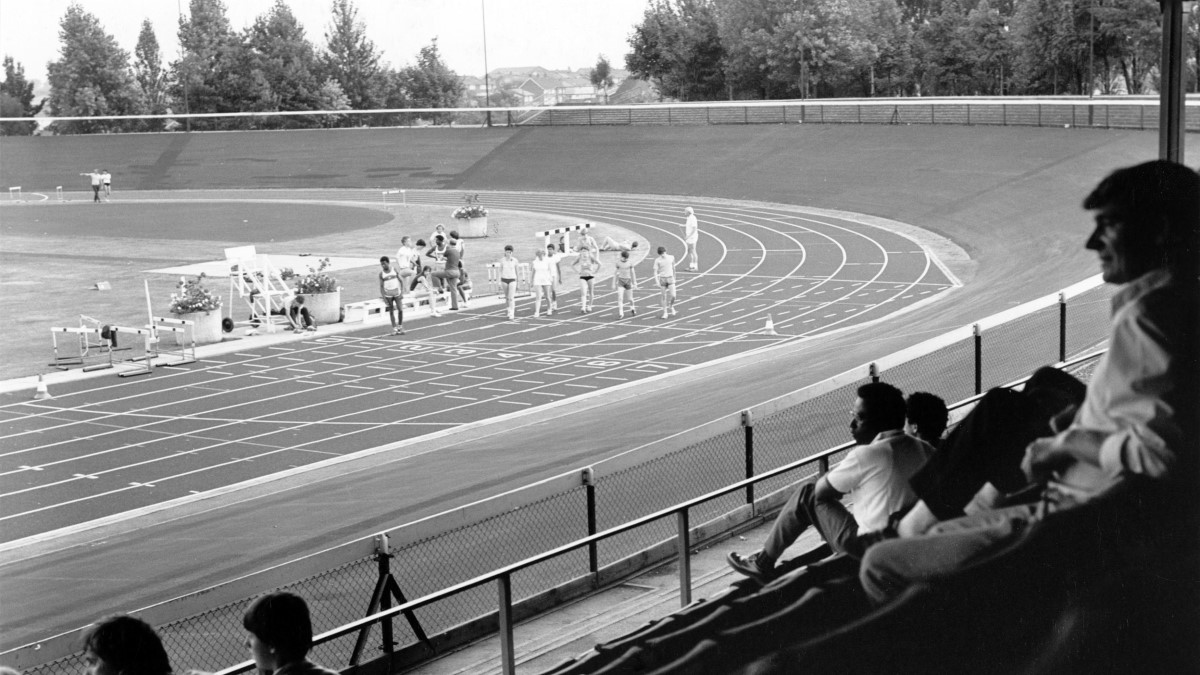
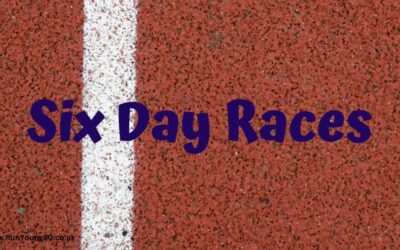
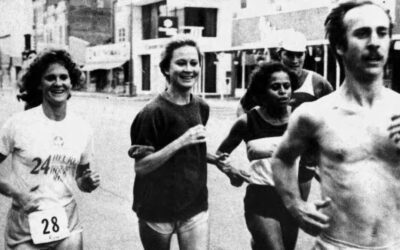
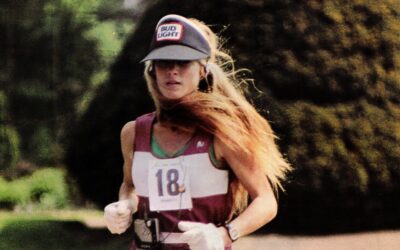
0 Comments